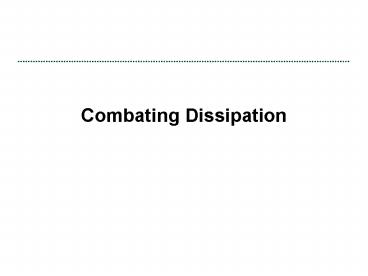Combating Dissipation - PowerPoint PPT Presentation
Title:
Combating Dissipation
Description:
High Order/Resolution Schemes. That said, we can do a lot better than ... High resolution methods: high order except near sharp regions. Sharpening semi-Lagrangian ... – PowerPoint PPT presentation
Number of Views:55
Avg rating:3.0/5.0
Title: Combating Dissipation
1
Combating Dissipation
2
Numerical Dissipation
- There are several sources of numerical
dissipation in these simulation methods - Error in advection step
- Pressure projection (time splitting)
- Not addressed yet in graphics!
- Level set redistancing
- Focus on the first
3
Dissipation Example (1)
- Start with a function nicely sampled on a grid
4
Dissipation Example (2)
- The function moves to the left(perfect
advection) and is resampled
5
Dissipation Example (3)
- And now we interpolate from new sample values,
and ruin it all!
6
The Symptoms
- For velocity
- Too viscous or sticky (molasses), or at an
implausible length scale (scale model) - Turbulent detail quickly blurred away
- For smoke concentration
- Smoke diffuses into thin air too fast,nice sharp
profiles or thin features vanish - For level sets
- Water evaporates into thin air, bubbles disappear
7
High Order/Resolution Schemes
- That said, we can do a lot better
thanfirst-order semi-Lagrangian - High order methods use more data points to get
more accurate interpolation - Cancel out more terms in Taylor series
- Problem inevitably can give undershoot/overshoot
(too aggressive) - Stability for nonlinear problems?
- High resolution methods high order except near
sharp regions
8
Sharpening semi-Lagrangian
- Can also do better with semi-Lagrangian approach
- Sharper interpolation- e.g. limited Catmull-Rom
Fedkiw et al 02 - Estimating error and subtracting it
- BFECC e.g. Kim et al 05
- Using derivative information
- CIP e.g. Yabe et al. 01
9
Example
- Exact (particles) vs. 1st order vs. BFECC
10
Aside resampling
- Closely related to the sampling
theoremfrequencies above a certain limit cannot
be reliably recovered on a grid - Sharp features have infinitely high frequency!
- Schemes which use an Eulerian grid as fundamental
structure are inherently limited(forced to use
higher resolution than is strictly necessary)
11
Particle-in-Cell Methods
- Back to Harlow, 1950s, compressible flow
- Abbreviated PIC
- Idea
- Particles handle advection trivially
- Grids handle interactions efficiently
- Put the two together- transfer quantities to
grid- solve on grid (interaction forces)-
transfer back to particles- move particles
(advection)
12
PIC
- Start with particles
- Transfer to grid
- Resolve forces on grid
- Gravity, boundaries, pressure, etc.
- Transfer velocity back to particles
- Advect move particles
- Start with particles
- Transfer to grid
- Resolve forces on grid
- Gravity, boundaries, pressure, etc.
- Transfer velocity back to particles
- Advect move particles
13
PIC
- Start with particles
- Transfer to grid
- Resolve forces on grid
- Gravity, boundaries, pressure, etc.
- Transfer velocity back to particles
- Advect move particles
- Start with particles
- Transfer to grid
- Resolve forces on grid
- Gravity, boundaries, pressure, etc.
- Transfer velocity back to particles
- Advect move particles
14
PIC
- Start with particles
- Transfer to grid
- Resolve forces on grid
- Gravity, boundaries, pressure, etc.
- Transfer velocity back to particles
- Advect move particles
15
PIC
- Start with particles
- Transfer to grid
- Resolve forces on grid
- Gravity, boundaries, pressure, etc.
- Transfer velocity back to particles
- Advect move particles
16
PIC
- Start with particles
- Transfer to grid
- Resolve forces on grid
- Gravity, boundaries, pressure, etc.
- Transfer velocity back to particles
- Advect move particles
17
FLuid-Implicit-Particle (FLIP)
- Problem with PIC we resample (average) twice
- Even more numerical dissipation than pure
Eulerian methods! - FLuid-Implicit-Particle (FLIP) Brackbill
Ruppel 86 - Transfer back the change of a quantity from grid
to particles, not the quantity itself - Each delta only averaged once no accumulating
dissipation! - Nearly eliminated numerical dissipation from
compressible flow simulation - Incompressible FLIP ZhuBridson05
18
Wheres the Catch?
- Accuracy
- When we average from particles to grid, simple
weighted averages is only first order - Not good enough for level sets
- Noise
- Typically use 8 particles per grid cell for
decent sampling - Thus more degrees of freedom in particles then
grid - The grid simulation cant see/respond to
small-scale particle variations can potentially
grow in time - Regularize e.g. 95 FLIP, 5 PICCan actually
determine ratio which matches a particular
physical viscosity!































